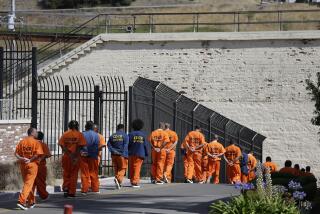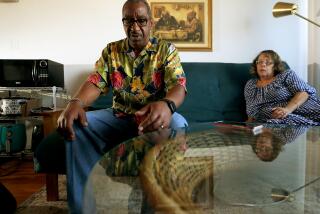An effort to stop overnight jail releases in California is rejected by Gov. Newsom

Ten years ago, Mitrice Richardson was released from the Los Angeles County sheriff’s Malibu/Lost Hills Station just after midnight, left to find her way home through a remote area, alone and on foot, with no money or phone.
When her body was located 11 months later, questions were raised about why the Sheriff’s Department let her go at an hour when there were few transportation options available and after she showed signs of a mental health crisis; she had been arrested after failing to pay her bill at a Malibu restaurant and exhibiting what was described as “strange behavior.”
Richardson’s case was one of the first late-night jail releases to draw scrutiny in California. But it wasn’t until another young black woman, Jessica St. Louis, died after leaving an Alameda County jail nine years later that California legislators sought to change a practice critics say is unfair and dangerous.
On Saturday, Gov. Gavin Newsom vetoed legislation to change the rules. Senate Bill 42 would have required county jails to allow those being released to stay until daylight hours if they chose, and to provide a safe place to wait for a ride and for the released inmate to charge a mobile phone while waiting after business hours.
Newsom cited the provision allowing inmates to wait until morning to leave as a costly mandate on local governments that would have to be reimbursed by the state. He wrote in his veto message that, although late-night jail releases were “simply an unsafe practice, resulting in many tragic and preventable outcomes over the years,” they should be addressed with a more “tailored” approach that “does not put the state treasury on the hook for local jail operations costs.”
State Sen. Nancy Skinner (D-Berkeley), the bill’s author, said the understood the budget concerns but “the reality here is lives are at stake.”
“This notion that there is a more targeted way to do it that would cost less, no one has recommended yet,” she said. “There are not very many people released from jail that are going to opt to stay in the safe place until business hours. There just won’t be that many, but if it saves even one life, that’s good enough.”
Skinner took up the issue after learning about St. Louis’ death, which occurred a few hours after she was released in July 2018.
St. Louis, 26, left Alameda County‘s Santa Rita Jail in Dublin, a suburb east of the San Francisco Bay, around 1:30 a.m. without money or her cellphone. She had served 11 days for a probation violation, according to Sheriff’s Sgt. Ray Kelly. Her body was discovered the next morning at the nearest transit station, which would have required a walk through an isolated area. A coroner later determined that St. Louis died of a drug overdose involving fentanyl, though, as with the Richardson case, her family is unsatisfied with the investigation.
A coalition of women, some of whom were previously incarcerated, created and wrote articles for a website about St. Louis’ case and received feedback from others who had been released under similar circumstances.
“We started to hear from women, ‘Oh, I have been on that walk before,’” said Krea Gomez, a member of the Sister Warriors Freedom Coalition, the group behind the website “We were hearing from men and women about how messed up it is to have to take that 1.9-mile walk from Santa Rita to the BART station ... While this death was an isolated incident, the impact from the walk could potentially have dangerous consequences for many people.”
The group invited Skinner to join them for a nighttime march from the jail to the transit station. The walk was “basically on remote and deserted streets,” Skinner said.
“It was chilling to me,” she said. “I just thought, no, this is not right.”
SB 42 would have applied to anyone released from jail but was written with women and the transgender community in mind, Gomez said. Skinner said that because county jails are often in outlying areas, women can be especially at risk from sex traffickers and others who target them after their release.
“There are predatory individuals who hang out in remote areas at night near jails,” Skinner said. “It doesn‘t take much imagination that anybody hanging out near a jail in a remote location in the middle of the night does not have good intentions.”
Assemblywoman Sydney Kamlager-Dove (D-Los Angeles), a co-author of the bill, said Richardson came to mind when she signed on to support the measure. “I also thought of the many instances in Los Angeles where inmates are released and unceremoniously discarded onto our streets,” she said prior to Newsom’s veto. “Our indifference towards the incarcerated and formerly incarcerated costs us too much. Humanity is not that costly of an investment.”
The Richardson case has never been closed.
Late-night releases can also present a danger to communities. On New Year’s Eve 2014, Gary Lee Bullock was released from jail late at night in the Humboldt County city of Eureka, about 60 miles from where he had been arrested, with no transportation readily available.
Bullock wandered to a nearby church where, in the early morning hours, he killed a Catholic priest and took his car, according to media reports. Bullock was convicted on charges including first-degree murder and torture, and sentenced to two life terms. A Humboldt County grand jury found it was one of three deaths within a one-year period in the county that involved people who were released from jail in the late night or early morning hours.
The issue of late-night jail releases has also gained national attention in recent years. Philadelphia city jails have drawn scrutiny after a media investigation found prisoners were released late at night, often without their personal possessions. A jail in Maine also changed its policies last month to end the practice.
Skinner’s bill was approved by the Legislature despite opposition from the California State Sheriffs’ Assn., which voiced concerns similar to those in Newsom’s veto message.
“While county jails are responsible for the care of inmates while in physical custody, the reach and responsibility of public entities can only extend so far,” the association wrote in a letter opposing the bill. “Such a mandate creates space and cost challenges.”
Amika Mota, policy director for the Sister Warriors Freedom Coalition, said her group was disappointed by Newsom’s veto but added the governor’s staff promised to meet with the activists in the coming days.
Skinner said she was unsure if she will bring the legislation back next year. She pointed out that counties are currently free to address the problem themselves, without a new state law, and said she hopes more local sheriffs will do so.
“The sheriffs have the power to do the right thing,” Skinner said.
More to Read
Start your day right
Sign up for Essential California for news, features and recommendations from the L.A. Times and beyond in your inbox six days a week.
You may occasionally receive promotional content from the Los Angeles Times.







